Chapter 3 – Sections & Objectives
- 3.1 Dynamic Routing Protocols
- Explain the purpose of dynamic routing protocols.
- Explain the use of dynamic routing and static routing
- 3.2 RIPv2
- Configure the RIPv2 routing protocol.
- 3.3 The Routing Table
- Explain the components of an IPv4 routing table entry for a given route.
- Explain the parent/child relationship in a dynamically built routing table.
- Determine which route will be used to forward a IPv4 packet.
- Determine which route will be used to forward a IPv6 packet.
- 3.4 Summary
3.1 Dynamic Routing Protocols
3.1.1 Dynamic Routing Protocol Overview
Dynamic Routing Protocol Evolution
- Dynamic routing protocols have been used in networks since the late 1980s.
- Newer versions support the communication based on IPv6.
Routing Protocols Classification

Dynamic Routing Protocols Components
Routing Protocols are used to facilitate the exchange of routing information between routers.
The purpose of dynamic routing protocols includes:
- Discovery of remote networks
- Maintaining up-to-date routing information
- Choosing the best path to destination networks
- Ability to find a new best path if the current path is no longer available
Main components of dynamic routing protocols include:
- Data structures – Routing protocols typically use tables or databases for its operations. This information is kept in RAM.
- Routing protocol messages – Routing protocols use various types of messages to discover neighboring routers, exchange routing information, and other tasks to learn and maintain accurate information about the network.
- Algorithm – Routing protocols use algorithms for facilitating routing information for best path determination.
3.1.2 Dynamic versus Static Routing
Static Routing Uses
Networks typically use a combination of both static and dynamic routing.
Static routing has several primary uses:
- Providing ease of routing table maintenance in smaller networks that are not expected to grow significantly.
- Routing to and from a stub network. A network with only one default route out and no knowledge of any remote networks.
- Accessing a single default router. This is used to represent a path to any network that does not have a match in the routing table.
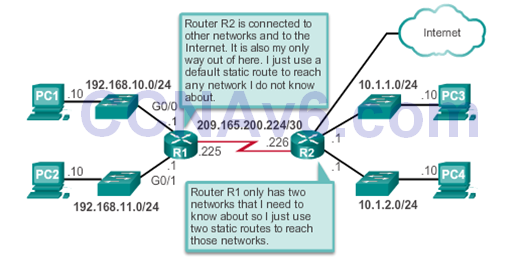
Static Routing Advantages and Disadvantages
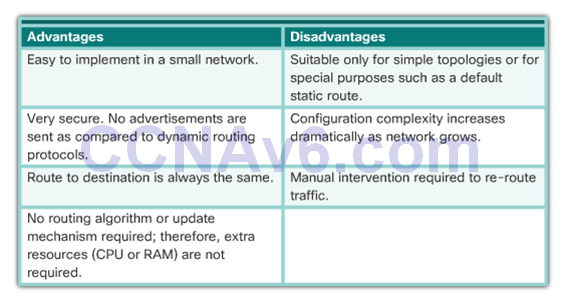
Dynamic Routing Advantages & Disadvantages
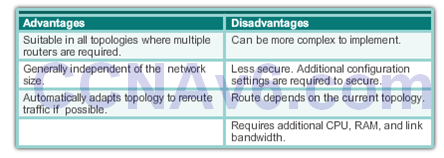
3.2 RIPv2
3.2.1 Configuring the RIP Protocol
Router RIP Configuration Mode

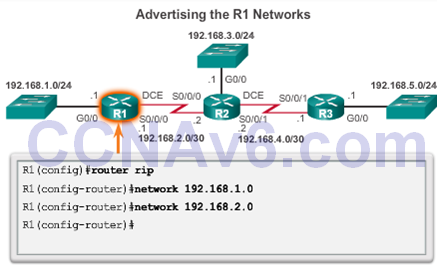
Verify RIP Routing
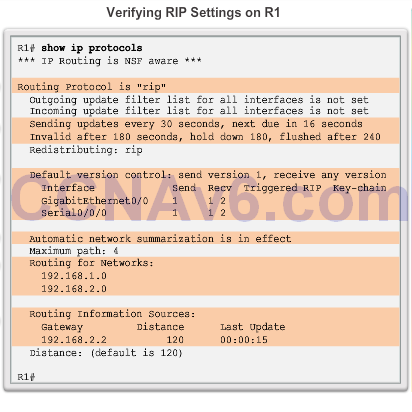
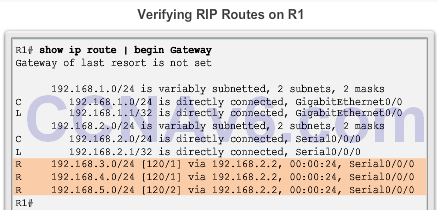
Enable and Verify RIPv2
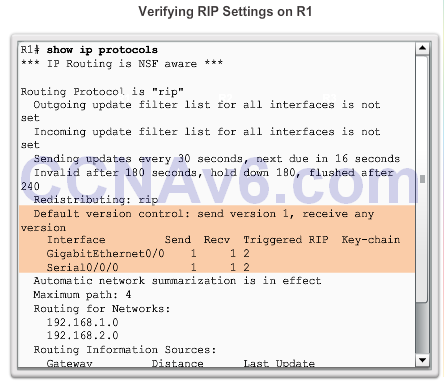
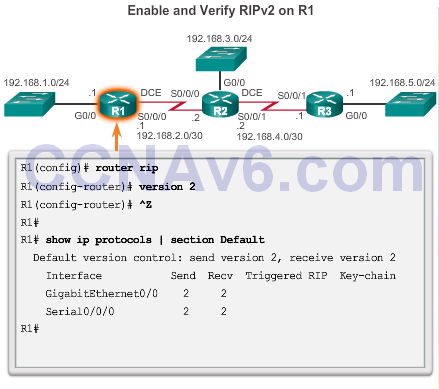
Disable Auto Summarization
- Similarly to RIPv1, RIPv2 automatically summarizes networks at major network boundaries by default.
- To modify the default RIPv2 behavior of automatic summarization, use theno auto-summaryrouter configuration mode command.
- This command has no effect when using RIPv1.
- When automatic summarization has been disabled, RIPv2 no longer summarizes networks to their classful address at boundary routers. RIPv2 now includes all subnets and their appropriate masks in its routing updates.
- Theshow ip protocolsnow states that automatic network summarization is not in effect.
Configuring Passive Interfaces
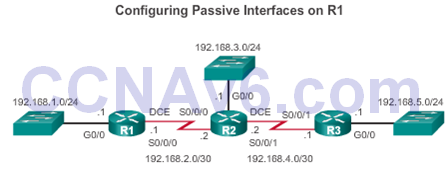
Sending out unneeded updates on a LAN impacts the network in three ways:
- Wasted Bandwidth
- Wasted Resources
- Security Risk
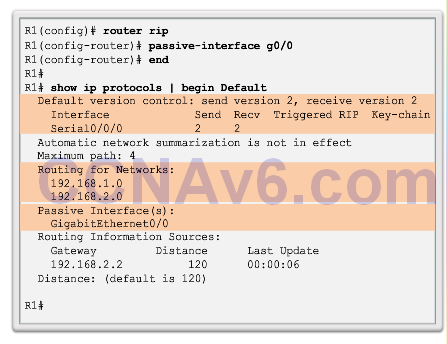
Propagate a Default Route
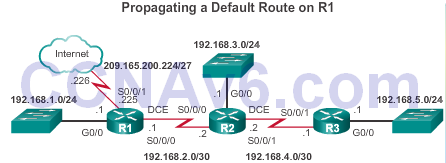

3.3 The Routing Table
3.3.1 Parts of an IPv4 Route Entry
Routing Table Entries
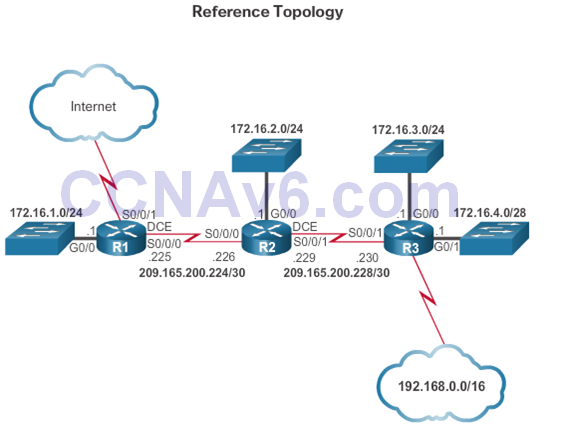
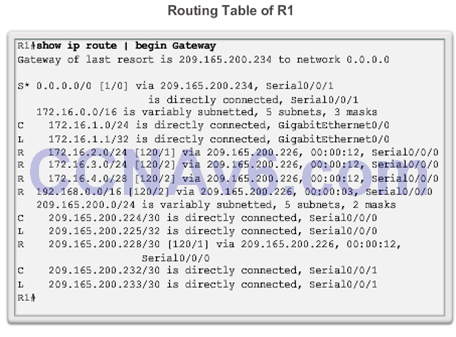
Directly Connected Entries

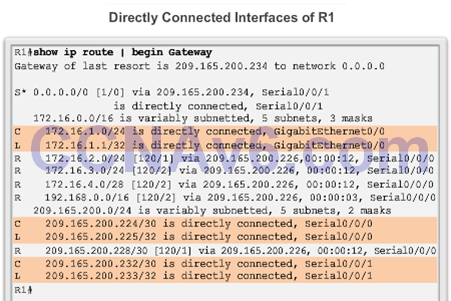
Remote Network Entries
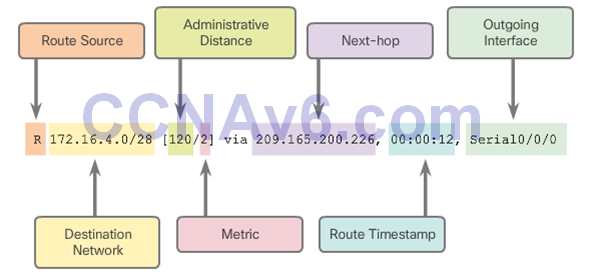
3.3.2 Dynamically Learned IPv4 Routes
Routing Table Terms
- Routes are discussed in terms of:
- Ultimate route
- Level 1 route
- Level 1 parent route
- Level 2 child routes
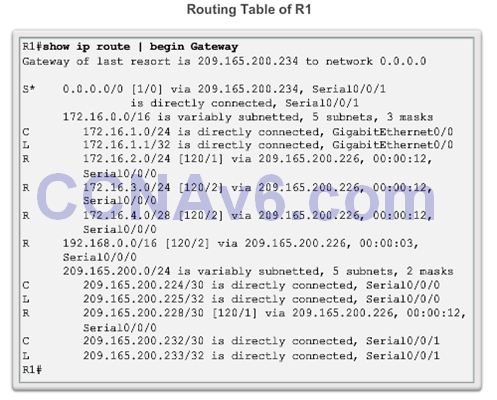
Ultimate Route
- An ultimate route is a routing table entry that contains either a next-hop IP address or an exit interface.
- Directly connected, dynamically learned, and link local routes are ultimate routes.
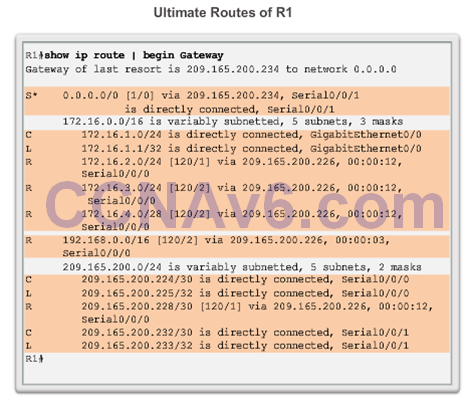
Level 1 Route

Level 1 Parent Route

Level 2 Child Route

3.3.3 The IPv4 Route Lookup Process
Route Lookup Process
- If the best match is a level 1 ultimate route, then this route is used to forward the packet.
- If the best match is a level 1 parent route, proceed to the next step.
- The router examines child routes (the subnet routes) of the parent route for a best match.
- If there is a match with a level 2 child route, that subnet is used to forward the packet.
- If there is not a match with any of the level 2 child routes, proceed to the next step.
- The router continues searching level 1 supernet routes in the routing table for a match, including the default route, if there is one.
- If there is now a lesser match with a level 1 supernet or default routes, the router uses that route to forward the packet.
- If there is not a match with any route in the routing table, the router drops the packet.
Best Route = Longest Match

3.3.4 Analyze an IPv6 Routing Table
IPv6 Routing Table Entries
- Components of the IPv6 routing table are very similar to the IPv4 routing table (directly connected interfaces, static routes, and dynamically learned routes).
- IPv6 is classless by design, all routes are effectively level 1 ultimate routes. There is no level 1 parent of level 2 child routes.
Directly Connected Entries


Remote IPv6 Network Entries


3.4 Summary
Dynamic routing protocols:
- Used by routers to automatically learn about remote networks from other routers.
- Purpose includes: discovery of remote networks, maintaining up-to-date routing information, choosing the best path to destination networks, and ability to find a new best path if the current path is no longer available.
- Best choice for large networks but static routing is better for stub networks.
- Function to inform other routers about changes.
- Responsible for discovering remote networks, as well as maintaining accurate network information.
- Upon a change in the topology routing protocols propagate that information throughout the routing domain.
- Convergence: The process of bringing all routing tables to a state of consistency, where all of the routers in the same routing domain, or area, have complete and accurate information about the network. Some routing protocols converge faster than others.
- Cisco routers use the administrative distance value to determine which routing source to use.
- Each dynamic routing protocol has a unique administrative value, along with static routes and directly connected networks.
- Directly connected networks are preferred source, followed by static routes and then various dynamic routing protocols.
- Each dynamic routing protocol has a unique administrative value, along with static routes and directly connected networks. The lower the administrative value, the more preferred the route source.
- A directly connected network is always the preferred source, followed by static routes and then various dynamic routing protocols.
- Routing table entries contain a route source, a destination network, and an outgoing interface.
- Route sources can be either connected, local, static, or from a dynamic routing protocol.
- IPv4 routing tables can contain four types of routes: ultimate routes, level 1 routes, level 1 parent routes, and level 2 child routes.
- Because IPv6 is classless by design, all routes are effectively level 1 ultimate routes. There is no level 1 parent of level 2 child routes.
Section 3.1
Terms and Commands
- Static routing
- Dynamic routing
- RIPv1
- RIPv2
- OSPF
- IS-IS
- IGRP
- EIGRP
- BGP
- Routing table
- Stub network
- Update messages
Section 3.2
Terms and Commands
- router rip
- no router rip
- network network-address
- show ip protocols
- show ip route
- version 2
- no version
- no auto-summary
- passive-interface
- passive-interface default
- no passive-interface
- ip route 0.0.0.0 0.0.0.0
- default-information originate
Section 3.3
Terms and Commands
- Classful routing
- Classless addressing
- Route source (C and L)
- Destination network
- Outgoing interface
- Administrative distance (AD)
- Metric
- Route timestamp
- Ultimate route
- Level 1 route
- Level 1 parent route
- Level 2 child route
- Network route
- Supernet route
- Default route
Download Slide PowerPoint (pptx):
